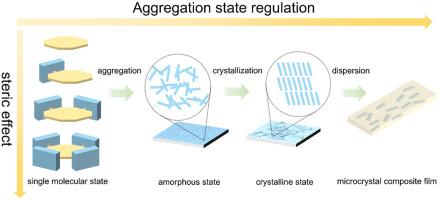调节芘-芴体系中的CLoSE效应:位阻对固态发光效率的影响
IF 4.2
3区 工程技术
Q2 CHEMISTRY, APPLIED
引用次数: 0
摘要
有机荧光分子在固态聚集中的猝灭现象是制约有机发光器件发展的关键因素。晶体诱导发光或/和稳定性增强(CLoSE)效应是解决这一问题的有效途径,其特点是发光效率从非晶态提高到晶态。在这里,我们研究了大体积基团的分子设计与CLoSE效应之间的关系。与不同数目的聚苯芴(PF)共价连接的芘(Py)的自组装行为和光物理性质表明,适当增加PF基团有助于增强CLoSE效应(DPF-Py的PLQY从12%提高到62%)。然而,过量引入位阻抑制了结晶,从而削弱了CLoSE效应(FPF-Py的PLQY仅增加了3%)。为了解决这个问题,我们将微晶体分散在聚合物基质中,减少了晶体表面缺陷引起的发光猝灭,进一步提高了固态聚集的发光效率。本文章由计算机程序翻译,如有差异,请以英文原文为准。

Modulating the CLoSE effect in pyrene-fluorene systems: The impact of steric hindrance on solid-state luminescence efficiency
The quenching phenomenon of organic fluorescent molecules in solid-state aggregation is a critical factor limiting the development of organic light-emitting devices. The crystal-induced luminescence or/and stability enhancement (CLoSE) effect featured with the enhancement of luminescence efficiency from amorphous to crystalline state proved to be an effective pathway to address this issue. Here we investigate the relationship between the molecular design of bulky groups and the CLoSE effect. The self-assembly behaviors and photophysical properties of Pyrene (Py) covalently connected with different numbers polyphenylfluorene (PF) groups indicate that a moderate increase of PF groups helps to enhance the CLoSE effect (the PLQY of DPF-Py increased from 12 % to 62 %). However, the excessive introduction of steric hindrance inhibited the crystallization and thereby weakened the CLoSE effect (the PLQY of FPF-Py increased by only 3 %). To address this, we dispersed the microcrystals in a polymer matrix, reducing the luminescence quenching caused by surface defects of the crystals, further enhancing luminescence efficiency in solid-state aggregation.
求助全文
通过发布文献求助,成功后即可免费获取论文全文。
去求助
来源期刊

Dyes and Pigments
工程技术-材料科学:纺织
CiteScore
8.20
自引率
13.30%
发文量
933
审稿时长
33 days
期刊介绍:
Dyes and Pigments covers the scientific and technical aspects of the chemistry and physics of dyes, pigments and their intermediates. Emphasis is placed on the properties of the colouring matters themselves rather than on their applications or the system in which they may be applied.
Thus the journal accepts research and review papers on the synthesis of dyes, pigments and intermediates, their physical or chemical properties, e.g. spectroscopic, surface, solution or solid state characteristics, the physical aspects of their preparation, e.g. precipitation, nucleation and growth, crystal formation, liquid crystalline characteristics, their photochemical, ecological or biological properties and the relationship between colour and chemical constitution. However, papers are considered which deal with the more fundamental aspects of colourant application and of the interactions of colourants with substrates or media.
The journal will interest a wide variety of workers in a range of disciplines whose work involves dyes, pigments and their intermediates, and provides a platform for investigators with common interests but diverse fields of activity such as cosmetics, reprographics, dye and pigment synthesis, medical research, polymers, etc.
 求助内容:
求助内容: 应助结果提醒方式:
应助结果提醒方式:


